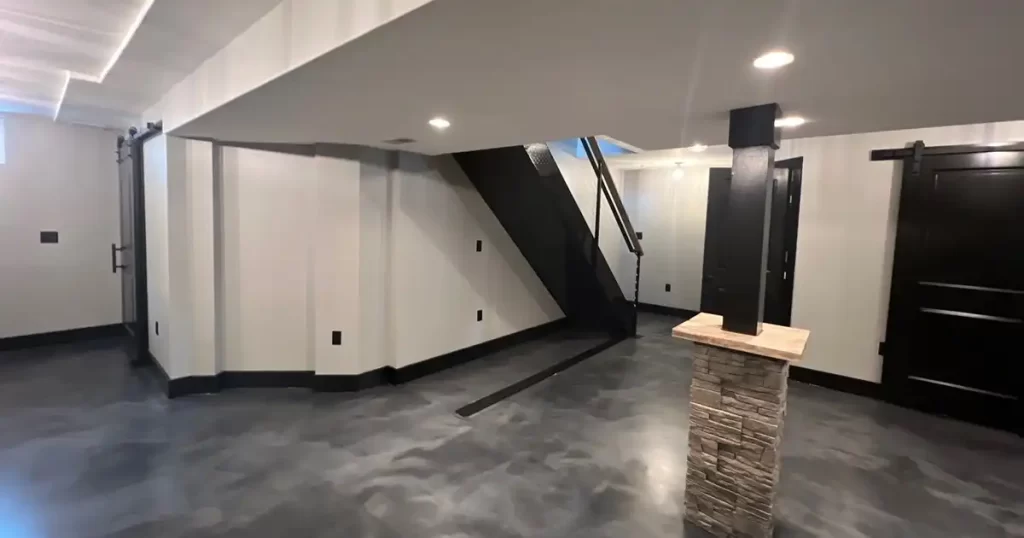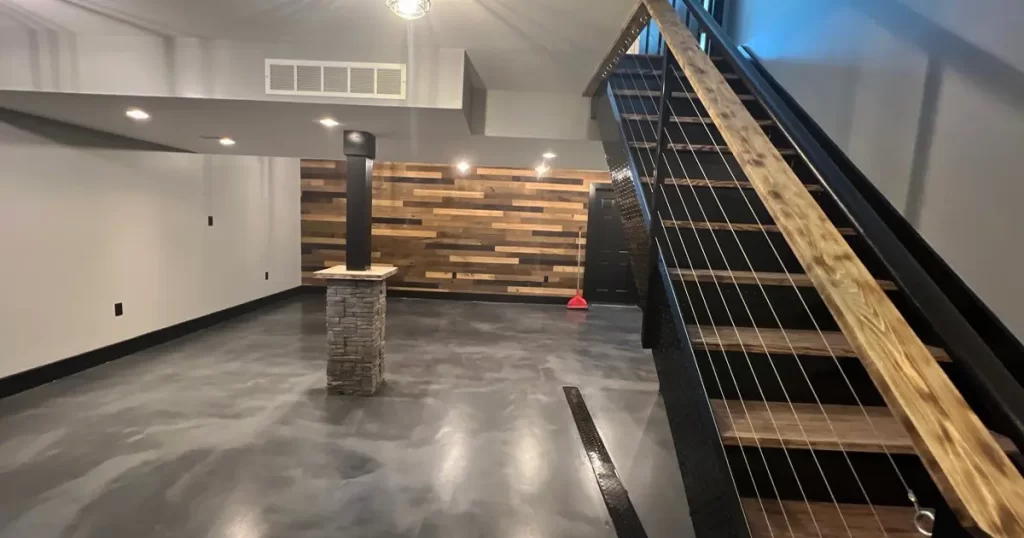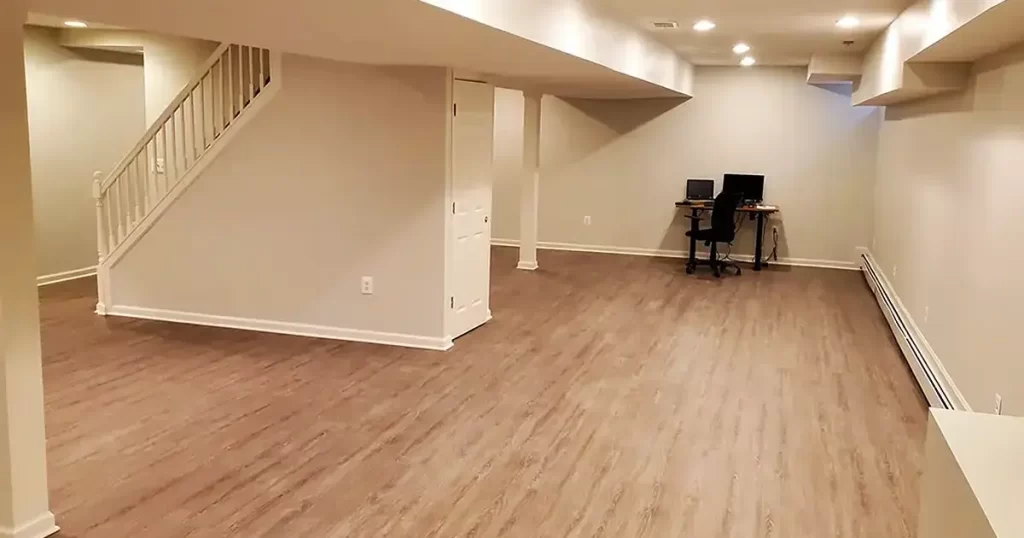Transforming your basement into livable space is one of the smartest ways to expand your home’s function and value. A well-planned basement renovation can create room for family activities, add private guest quarters, or even boost resale appeal.
In Pasadena, Maryland, where many homes have unfinished lower levels, this basement renovation checklist guides you through every essential stage, including planning, budgeting, construction, and maintenance, with practical, experience-driven advice to help you avoid costly mistakes.

1. Start with Purpose and Planning
Every solid renovation starts with clear intent. Ask yourself what the new basement should accomplish. Some homeowners want a home office or gym, while others build a family room, in-law suite, or media lounge. Clarity at this stage avoids layout changes later.
Decide early if you’re finishing or remodeling the basement.
- Finishing means turning an unfinished space into something usable by adding insulation, flooring, and walls.
- Remodeling means upgrading or changing existing finished space, like adding a bathroom or kitchen area.
A simple sketch can go a long way. Mark where you’ll place doors, walls, or utilities. Think ahead, today’s playroom can become tomorrow’s office or guest suite.
2. Create a Realistic Budget
Basement renovations in Maryland typically start around $35,000 for a standard remodel, depending on the size, complexity, and finishes. A full remodel that includes added bathrooms, custom layouts, or high-end materials can reach $200,000 or more.
Keep these budgeting principles in mind:
- Stay proportional. Don’t invest more than 20% of your home’s total value.
- Add a 15% contingency. Older basements often reveal surprises: leaks, wiring issues, or uneven floors.
- Prioritize essentials. Waterproofing and insulation come before cosmetic finishes.
Financing options include savings, personal loans, or home equity lines. Compare total interest and repayment terms before committing.
3. Assess the Space Before You Build
Basements come with challenges that require proper inspection before any construction starts. A professional home evaluation can save thousands later.
Moisture Control
Water is the top enemy of any basement project. Test for dampness by taping plastic sheets to the floor and walls for 48 hours. If condensation forms underneath, you have a moisture issue.
- Redirect gutters and downspouts at least 10 feet away from the foundation.
- Grade soil to slope away from your home.
- Seal cracks using hydraulic cement.
- Consider sump pumps or French drains for persistent water problems.
Air Quality and Safety
- Test for radon, a colorless gas found in Maryland soil. If readings exceed safe levels, install a mitigation system.
- Check for asbestos if the home was built before 1980.
- Inspect beams, joists, and subfloors for rot or termite damage.
Ceiling Height
Local building codes in Pasadena and Anne Arundel County follow the International Residential Code (IRC) Section R305.1, which requires a minimum ceiling height of 7 feet (2134 mm) for habitable basement spaces.
Beams, ducts, and other obstructions are permitted to project to within 6 feet 4 inches (1931 mm) from the finished floor. If your basement ceiling is lower, you may need to lower the floor or modify the framing to meet code.
These adjustments are complex and should be handled by a licensed contractor or structural engineer familiar with local regulations.
4. Know the Local Permits and Codes
In Pasadena and Anne Arundel County, basement projects must follow specific codes for safety, plumbing, and electrical systems. Any project that adds outlets, lighting, or plumbing typically requires permits.
If you plan to create a bedroom, you’ll need an egress window or door that allows direct exit outdoors. These are legal requirements for fire safety, not optional features. Always confirm with the Anne Arundel County permitting office before starting work.

5. Hire the Right Contractor
Basement projects look simple on paper but can quickly grow complex. Work with a licensed basement remodeling local contractor who understand Maryland’s moisture and soil conditions. Ask for:
- Proof of licensing and insurance.
- Examples of similar basement projects.
- References from recent clients.
A professional contractor will handle permits, inspections, and coordination between electricians, plumbers, and HVAC specialists. For smaller cosmetic work, like painting or installing trim, you can DIY, but leave structural or system work to experts.
6. Prepare the Basement for Construction
Here’s the general sequence professionals follow to avoid backtracking and wasted effort:
- Waterproof and Clean Out. Resolve leaks and remove clutter before framing.
- Framing. Use pressure-treated wood for base plates and keep walls slightly off the concrete to prevent moisture transfer.
- Rough-In Utilities. Install plumbing, electrical, and HVAC lines early, before walls are closed.
- Insulation. Use rigid foam boards against foundation walls, then fill between studs with fiberglass or spray foam for better temperature control.
- Drywall. Choose moisture- and mold-resistant drywall. Keep it a few inches above the floor with removable baseboards for easier repair if minor flooding occurs.
- Ceiling. Decide between a drywall ceiling for a clean look or a drop ceiling for easy access to utilities.
- Paint. Start from the ceiling and move downward. Light, neutral colors brighten low-light spaces.
- Subfloor and Flooring. Level the slab if needed. Use moisture-safe flooring like vinyl plank, laminate, or low-pile carpet with vapor barriers. Avoid solid hardwood.
7. Design for Comfort, Style, and Function
A basement should feel like part of your home, not an afterthought. Focus on light, temperature, and usability.
Lighting: Combine recessed lighting for general illumination with wall sconces or floor lamps for warmth. If possible, add egress windows or light wells to bring in daylight.
Climate Control: Use a dedicated dehumidifier to maintain 30–50% humidity. Insulate exterior walls properly to reduce energy use. For high comfort, consider radiant floor heating.
Soundproofing: If you’re building a home theater or office, use acoustic panels or soundproof insulation in ceilings and shared walls.
Accessibility: Plan for long-term use with wide doors, non-slip flooring, and even-grade transitions between rooms.
Storage: Incorporate built-in shelving, closets, or hidden cabinetry. A well-organized basement stays cleaner and feels larger.
8. Final Inspections and Maintenance
Before closing out the project, perform a detailed walkthrough with your contractor. Verify that all lighting, plumbing, and HVAC systems function properly. If your renovation required a permit, schedule the final inspection to obtain a certificate of occupancy.
Ongoing Maintenance:
- Check for leaks or dampness each season.
- Keep gutters clear and grading correct.
- Clean and test your sump pump regularly.
- Replace HVAC and dehumidifier filters every few months.
Regular care protects your investment and ensures the space remains healthy and comfortable.

Renovating Basements in Pasadena, MD
Homes in Pasadena and nearby Anne Arundel County often have basements built below the water table, so waterproofing isn’t optional, it’s foundational. The local climate’s mix of humidity and rainfall makes moisture control, proper insulation, and ventilation critical.
Partnering with a local basement remodeling company like Brucksch & Sons Remodeling that understands these regional challenges can save time and money. Look for teams experienced in handling drainage, radon mitigation, and Anne Arundel County inspections.
Ready to Renovate Your Basement?
A well-planned basement renovation checklist keeps your project organized and safeguards your investment. With clear goals, realistic budgeting, and proper moisture control, you can turn unused square footage into a functional and comfortable extension of your home.
If you’re ready to start, our team at Brucksch & Sons Remodeling is here to help. We specialize in smart, long-lasting basement renovations in Pasadena, Maryland, handling everything from design and planning to permits and final inspections.
Our goal is to deliver spaces that are safe, durable, and built with craftsmanship you can trust. Call us today at (443) 261-9582 or submit your quote request to discuss your basement renovation project.
A basement renovation goes beyond surface updates. It’s about creating a smart, safe, and lasting living space that adds real value to your home. Use this checklist as your guide, and your Pasadena home will gain comfort, functionality, and purpose for years to come.
FAQs About Basement Renovations
1. How long does a typical basement renovation take?
Basement remodels usually take between 3 and 12 weeks, depending on the size, design complexity, and permit approvals. Adding bathrooms or high-end finishes may extend the timeline.
2. Do I need a permit to finish my basement in Pasadena, MD?
Yes. Anne Arundel County requires permits for structural, electrical, and plumbing work in finished basements. Always confirm with the county permit office before starting construction.
3. What’s the average cost of a basement renovation in Maryland?
A standard basement remodel in Maryland typically starts around $35,000. Larger or high-end projects with bathrooms or luxury finishes can reach $200,000 or more.
4. How do I prevent moisture problems in my basement?
Proper waterproofing and drainage are key. Check exterior grading, extend downspouts 10 feet from the foundation, and use sump pumps or dehumidifiers to manage humidity.
5. What kind of flooring works best for finished basements?
Choose moisture-resistant options like luxury vinyl plank (LVP), laminate, or low-pile carpet with a vapor barrier. Avoid solid hardwood, which can warp in humid conditions.
6. Can I turn my basement into a rental unit?
It’s possible, but you’ll need to meet zoning and egress requirements in Anne Arundel County. A separate entrance, kitchen, and proper ceiling height are usually required.
7. Is it worth hiring a professional for a basement remodel?
Yes. Basement projects involve structural work, waterproofing, and code compliance. A licensed local contractor ensures everything is safe, efficient, and up to Maryland standards.
